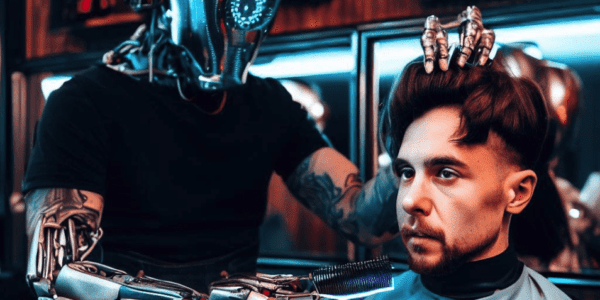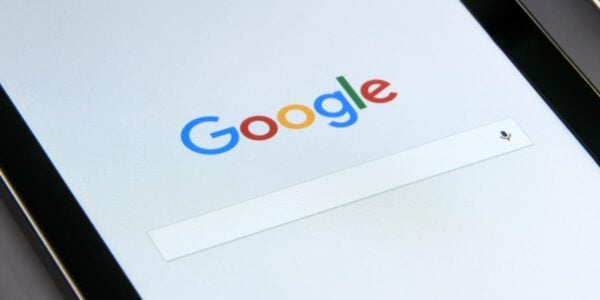Once upon a time…
SEO was mostly about just using a keyphrase a certain number of times. Not too many times or you look spammy. Not too few or you don’t look relevant. I did SEO back then. It was very weird and search results were bad. Those were dark days online.
Today…
Search engines are much better and SEO has evolved. Through research and experimentation, SEOs learned that it isn’t just about using the target keyphrase. Now, to indicate relevance and quality, the page should use the target keyphrase, but also the page should use the closely related phrases.
Here is a walkthrough of semantic SEO from my presentation at Content Jam 2023. It includes the step-by-step process for building search friendly content that goes beyond the primary target keyword.
Target the topic, not just the keyphrase
Google is a semantic search engine. It’s connecting visitors to answers on pages that contain the meaning they’re looking for, not just pages that match the words they typed into that little box.
So the key to rankings is to make a page that goes deeper into the meaning, increasing the chances that Google will consider it to be a great answer on the overall topic. That means finding and using the semantically related phrases.
 |
Kevin Indig, Growth Advisor, Kevin-Indig.com“If you think about it, Google wants to show the most comprehensive answer to a search. Searches are becoming clearer in intent due to LLMs, where users can enter much longer questions, and LLMs understand them much better. But short keywords (1-5 terms), as they’re used on Google today, are harder to interpret. Google can figure out what people want based on their behavior in the search results, but for content creators, it’s not as clear because they don’t have user behavior data. So, the goal of semantic SEO is essentially to understand what users really want and deliver the most comprehensive answer. Figuring out related searches and phrases is one part; another one is to know the topic you’re writing about and all of its facets deeply. I like to use SEO writer tools like Clearscope, Surfer, SWA (Semrush Writer Assistant), Sistrix, and others to figure out what the baseline of sub-topics is and then use human expertise to add an “edge” of insights on top.” |
SEOs used to call these phrases LSI (latent semantic indexing) keywords. Really they’re just the phrases that are related to the target keyphrase. These semantic keywords are connected within Google’s “ontological library” or whatever they call their way of mapping entities to one another.
When you build these into your content, you’re spreading your meaning out, creating more relevant content and a more detailed and comprehensive URL, which is what SEO and quality is all about.
- Incorporate closely related phrases
- Answer related questions
- Explore the related subtopics
Here we’ll walk through the process for semantic SEO and updating an existing page. But the process for creating new pages is the same. At the end of this post, we’ll share a real-world SEO case study showing real results from our own semantic SEO process.
Step 1: Find the closely related phrases
We’ll use an example of a spaceport that provides satellite launch services. We launch rockets for commercial satellite companies, so of course, we have a page about our launch services. Currently, it is not a search optimized page.
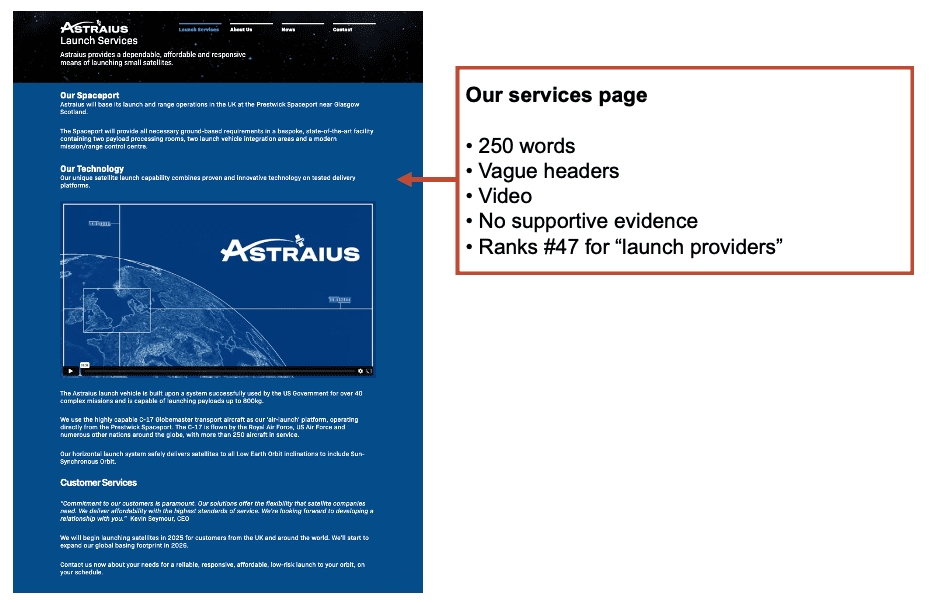 Any mid-level marketer could make this a better page, simply by following a few of the B2B service page best practices: add examples, data points, objection handling, faces of the team, social proof, calls to action, etc.
Any mid-level marketer could make this a better page, simply by following a few of the B2B service page best practices: add examples, data points, objection handling, faces of the team, social proof, calls to action, etc.
But here we’re focused on rankings and traffic. So we first need to confirm that we have used the primary target keyphrase, “spacecraft launch services,” in all of the most important places.
- Title tag
- Header
- Body text
- Meta description
That’s basic SEO and it’s the minimum for indicating relevance. Next we need to go beyond the target keyphrase. We need to find and incorporate all of the semantically related phrases.
The easiest way to find these phrases is to simply look in Google. We’ll use three sources straight from search results and the Google Knowledge Graph:
- Search snippets of competitors in the SERPs (search engine results page)
- The People Also Ask box (PAA)
- Google suggested phrases
We’ll start by just searching for our target keyphrase and scanning through the search results. What words appear in the featured snippet and the snippets of the other high-ranking pages? What are the bolded phrases? Many of these phrases are closely related to our target phrase. Put these on a list.
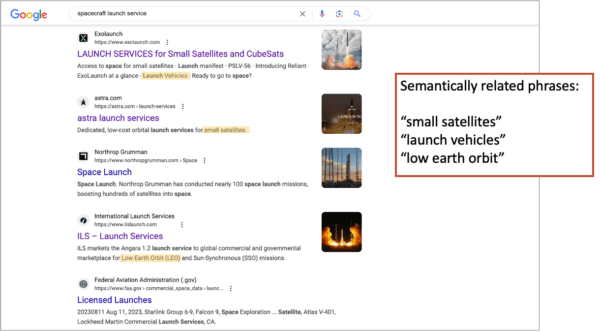 Next, we’ll search again (for our target phrase or another related phrase) and look for a “People also ask” box of related questions and in the knowledge panel on the side. Look at the questions and the phrases. See anything interesting? These are related to your target phrase. Put these on your list.
Next, we’ll search again (for our target phrase or another related phrase) and look for a “People also ask” box of related questions and in the knowledge panel on the side. Look at the questions and the phrases. See anything interesting? These are related to your target phrase. Put these on your list.
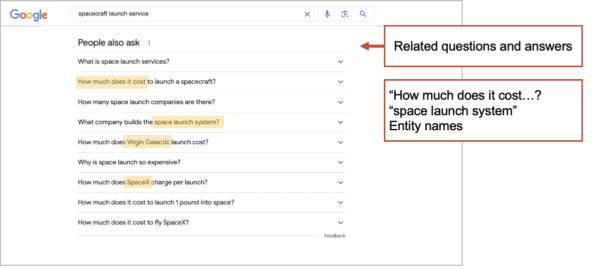 Finally, we can just start searching by typing in the search box and seeing what Google suggests. Try typing in another letter or two. See all of the suggested phrases? They’re related to your target keyphrase. Put these on your list.
Finally, we can just start searching by typing in the search box and seeing what Google suggests. Try typing in another letter or two. See all of the suggested phrases? They’re related to your target keyphrase. Put these on your list.
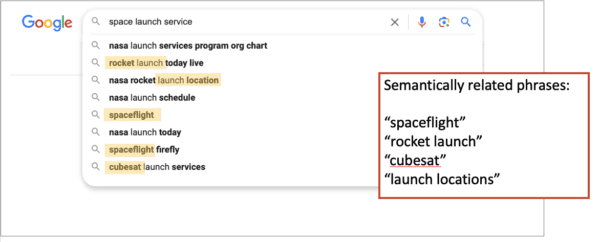
To see all of the phrases that Google suggests, as if you typed the next letter of the alphabet 26 times, use KeywordTool.io. It will show you all of the phrases at once. It also shows suggested phrases for YouTube, Bing, Amazon and many other search engines.
See anything relevant? Put these on your list.
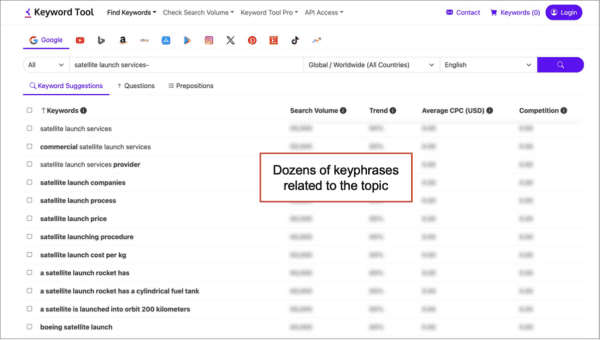 By now, you should have a list of all kinds of phrases, questions and subtopics that are adjacent to your target keyphrase. Before we start making SEO edits, let’s look at one more tool for identifying related phrases.
By now, you should have a list of all kinds of phrases, questions and subtopics that are adjacent to your target keyphrase. Before we start making SEO edits, let’s look at one more tool for identifying related phrases.
Market Muse is an SEO tool for optimizing content for search. Give it a phrase and your page, it will then scan the top 20 pages that rank for that phrase, analyzing their content. It shows which keywords they used and how many times, comparing their keyword frequency to yours.
At a glance, you can see which phrases they used but you did not. They are phrases you may want to incorporate. They are subtopics you may want to cover.
 Your list might be handwritten on paper, a bullet list in your content template, or an export from a tool. It’s time to go through the list and start updating the page.
Your list might be handwritten on paper, a bullet list in your content template, or an export from a tool. It’s time to go through the list and start updating the page.
Step 2: The SEO copy edit process
Start with missing major themes. If several of the phrases are categorically similar, think about ways to add a section that covers them. For example, adding a new section about types of rockets to the page above would create opportunities to mention several of the phrases: “rocket launch” “space launch systems” “launch vehicles”
Next, look for words and phrases that could be replaced. Usually, this just means replacing a vague word (“payload“) with a more specific phrase (“small satellites and other payloads“). This kind of content optimization is good for both rankings and readers.
Finally, confirm that you’re answering all of the related questions. Try to order the question-answering sections so they align with the audience’s top concerns. Each section should align with the information needs of your target audience.
Ideally, the semantic SEO copy edit process makes you a better writer by pushing you deeper into the content. It helps you write detailed, comprehensive writing. It reminds you to replace clever copy with clear copy.
⚠️ A few warnings for the SEO copy editor:
- No keyword stuffing. It’s unnecessary and bad for your readers. There’s no point in attracting a visitor if you immediately turn them off with a pile of copypasta.
- Don’t worry about plural forms or grammatical variations. Search engines aren’t really worried about minor differences. They’re worried about search intent and the meaning of the content.
- Skip the super questions. If you’re talking to commercial satellite operators on a service page, there’s no need to answer the question “What are space launch services?” Skip it or put it lower down on the page, possibly in a mini FAQ section. But if you’re doing content marketing, covering the basics makes more sense.
- There is no such thing as perfect SEO copy. Search optimization is an inexact science. When you start worrying about individual keyword variations and keyword frequency, pan out. Focus on answering the readers’ questions.
Remember, your research gave you clues, not specific instructions. The expert SEO is obsessed with quality, just like Google. Yes, we indicate relevance, but we are mostly just trying to make an amazing piece of content. A detailed page that is lightly optimized will outperform thin content that is dense with keyphrases.
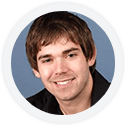 |
Jayson DeMers, EmailAnalytics“As Google refines its algorithm based on the way search queries are changing, we’re seeing on-page keyword and content-based features grow in importance. Ride that wave by ensuring your content is adapted to semantic search.” |
Bonus: How to use AI to suggest copy edits
Generative AI can be a useful tool for editing copy, as we all know by now. Letting an AI suggest SEO copy edits based on the existing copy and the list of semantic keywords is actually very simple. This is just one of the many ways AI can help you with SEO.
Here is the prompt:
You are an expert SEO, highly skilled in improving search rankings by enhancing content to incorporate semantically related phrases. I’m giving you a list of semantic keywords along with a draft of a webpage delimited by ///
Suggest edits to the page that would help it rank higher by better indicating relevance for the keyphrases provided. Focus on recommendations for including keyphrases that are not used on the page but do appear on the list.
Make suggestions that improve both the flow and clarity of the content, as well as keyword relevance. Highlight the recommended changes.
[paste in list] /// [paste in draft article]
That prompt may look very detailed, but it is not. The best prompts include all of those elements: role, goal, data, draft copy and detailed instructions.
Try it. It’s easy, fast, inexpensive and may be effective. Of course, you’ll still need to edit the recommendations carefully. But even if 80% of the recommendations are not useful, it’s still worthwhile. To make it more effective in the future, give your final edits back to the AI to train it to do a better job next time.
Step 3: Measure the results
Because we don’t really have a spaceport, we’ll switch now from our hypothetical example to an actual SEO case study from this blog.
We’ll use our article about “homepage best practices” as our SEO example. Here is the URL: https://www.orbitmedia.com/blog/what-to-put-on-your-homepage/
It was updated using this process 10 months ago, so we have data about the pre- and post-update performance for rankings and traffic. We’ll use Moz, GA4 and Google Search Console to measure the impact.
Measuring the content
The original article was already very detailed. But after the draft was done, the research still showed many opportunities for improvement. The final updated version was much longer and more detailed. Compare:
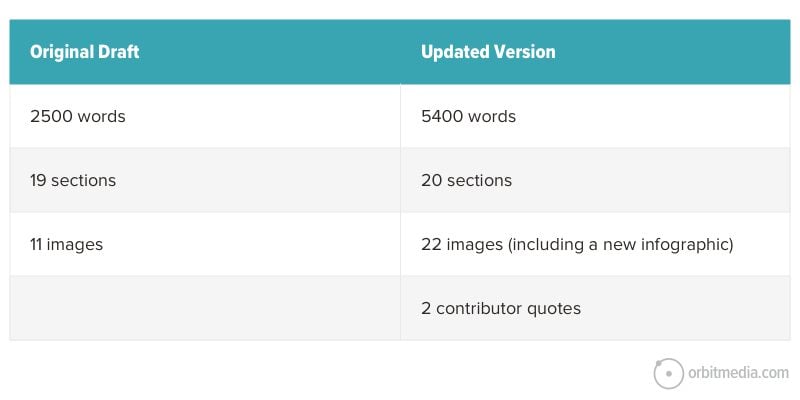
But really, the goal wasn’t to make it longer. The goal is always to make the best possible page on the internet for the topic. And because it’s a big topic, it ended up being a long article.
Does it have good technical SEO? Is there structured data and schema markup? Is it good web design and UX? Is it part of a topic cluster? Maybe. But the content is the most important search ranking factor.
During the final edits, the semantic research showed there were lots of missed keyword opportunities. Here you can see how some of the copy was edited to build in better relevance by including more of the semantic keywords.
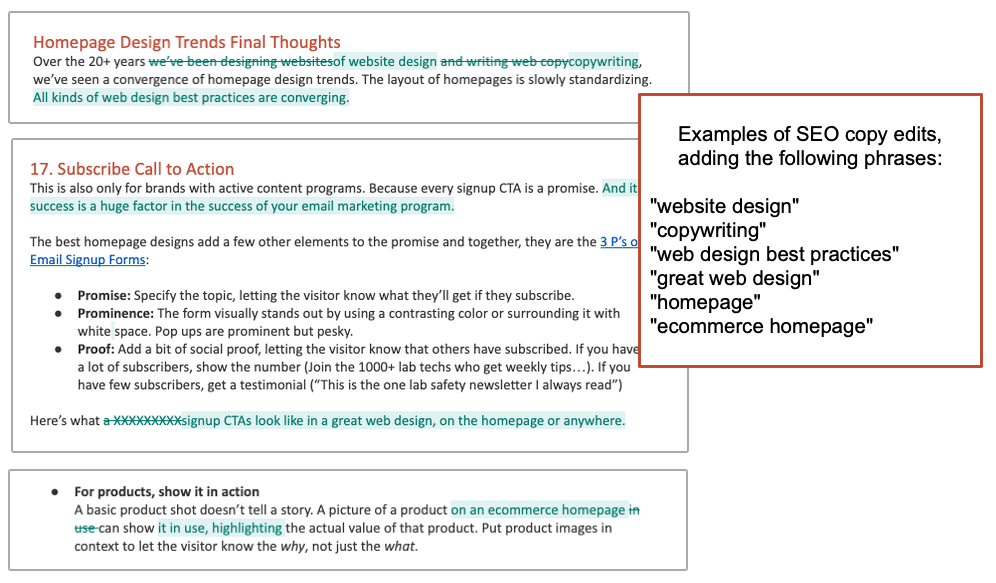
Measuring the rankings and traffic
If you use an SEO tool, make sure you’re tracking the target keyphrase. That means adding the keyphrase to the campaign in Moz or the project in Semrush. Start tracking before the updated page goes live or the new page is published.
There’s no need to do any setup in GA4. But to see the traffic to that URL separate from your other pages, you’ll need to create a quick GA4 Exploration: organic traffic segment, page path as the dimension, sessions as the metric, the URL in a filter.
Here are the results, both for rankings for the primary keyphrase and to traffic in Google Analytics, side-by-side:
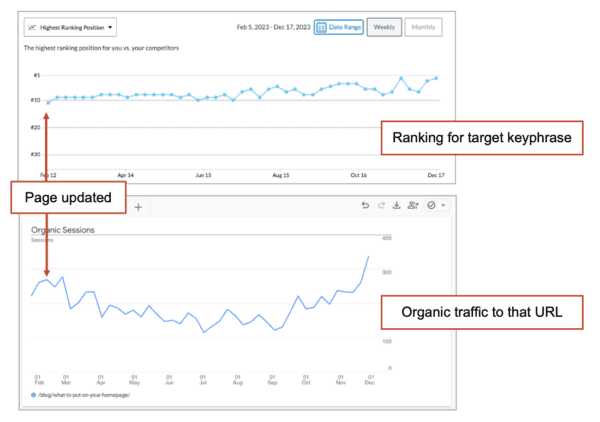
The impact to rankings took much longer than we expected. There was an immediate lift in rankings (from page two to page one) but it really took months before it started ranking in the top three.
Also notice the lag between ranking improvements and traffic improvements. This could be for several reasons. Google search results may be showing different SERP features that affect clickthrough rates. Or there may be seasonal impact on demand for the topic. Or phrases other than the keyphrase we tracked may be driving more of the impact.
Measuring the engagement rate of visitors
How do readers like it?
Visitors are actually much more engaged with the updated content. This isn’t surprising at all. Detailed, clearly written content is just what readers are looking for. It has strong topical authority.
In this example, the updated content has a 30% lift in engagement rate, a 22% drop in bounce rate and a 100% increase in average engagement time. The Google Analytics data shows that semantic search techniques align perfectly with visitor intent.
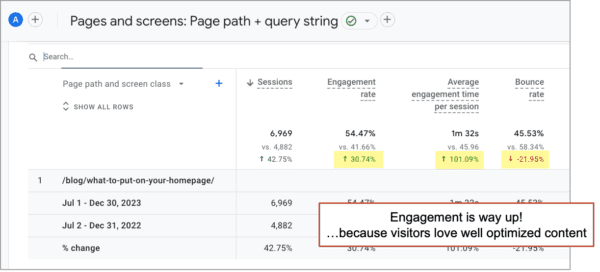
Measuring the number of ranking phrases
Detailed, comprehensive content ranks for more than just the target keyword. Updating a page to cover more of the semantic keywords and subtopics will cause it to rank higher for the primary keyphrase, but also to rank for many more closely related phrases.
Here is the before and after for the updated page in Google Search Console. The top chart shows the number of ranking keyphrases in the month prior to the update. The lower chart shows the number of ranking keyphrases in the month 10 months post-update.
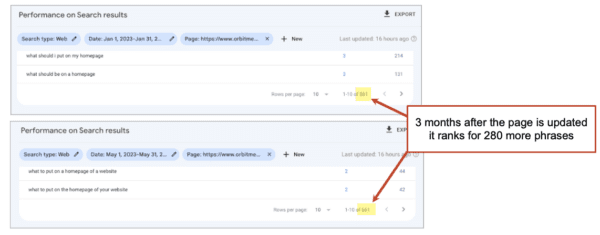
The new page ranks for 280 more phrases than the original. That’s 73% more phrases. Not only does the new page rank higher, it ranks more.
This brings us to a realization for digital marketers and SEO copywriters.
There are no pages that rank for only one phrase
Any page that ranks for anything, also ranks for dozens (or hundreds) of closely related phrases. Think through that and your perspective on search may change. You’ll go beyond traditional SEO and into entity SEO. You’ll start celebrating different outcomes. You’ll start looking at different reports.
Now you know why we de-emphasize “search volume” when doing keyphrase research. The SEO tools may estimate the demand for that specific phrase, but it is a wild underestimation of the demand for the overall topic.
Here’s the proof.
According to Semrush, the search volume for the target keyphrase “homepage best practices” is just 40 searches per month. That may be perfectly accurate. But the page attracts 400+ organic visitors per month. How?

It’s because the page is optimized using semantic SEO strategy, so it indicates relevance more broadly. In the end, it ranks for 600+ phrases. That’s why it gets 10x more traffic than the search volume for the target keyphrase.
Detailed, high-quality content that targets a keyphrase, but optimized for the broader topic. That’s what modern search engine optimization is all about.
The bottom line on top rankings
You don’t have to be a search engineer to adapt your content. You don’t need to understand “latent semantic indexing” or what an ontological library is. Although the brains behind the semantic web may be very complex, the process for making better content is not.
If you have actually made a page that provides the best answer to the question or offers the most detailed set of instructions, then the search engines are working very hard to help you …There are thousands of math PhDs on your side, doing their best to send visitors your way!
If you have not made a great page, then you’re just trying to trick a robot. You’re using links and keywords to win something you don’t deserve …There are thousands of computer scientists fighting against you, trying to keep you out of search results.
Colophon:
This URL was first published in December, 2015 and updated in May, 2018. It was originally about “future proofing your rankings” and included tips for featured snippets and user interaction signals. This version was published in January, 2024. The process for updating included all of the techniques listed here for semantic content. At the time of publishing, it ranked #5 for “semantic SEO” and attracted 1200 visitors per year. We’ll update this post with the impact of these recent changes!

